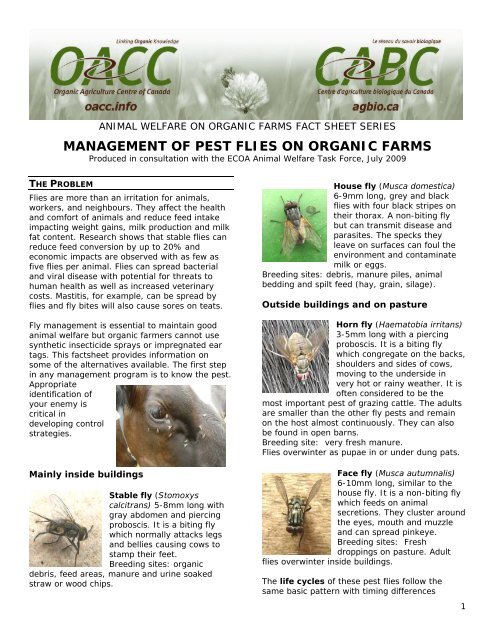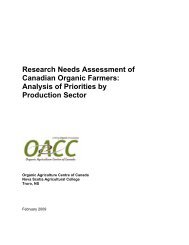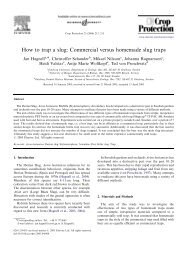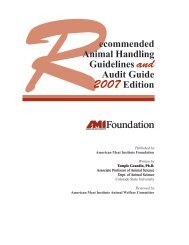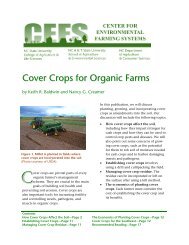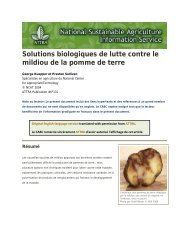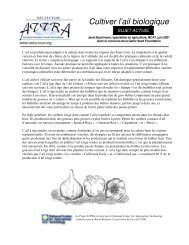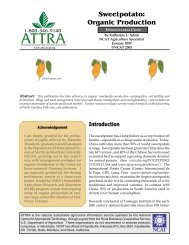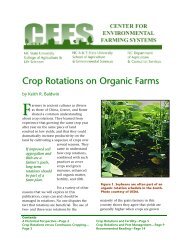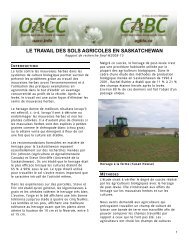management of pest flies on organic farms - Le centre d'agriculture ...
management of pest flies on organic farms - Le centre d'agriculture ...
management of pest flies on organic farms - Le centre d'agriculture ...
Create successful ePaper yourself
Turn your PDF publications into a flip-book with our unique Google optimized e-Paper software.
ANIMAL WELFARE ON ORGANIC FARMS FACT SHEET SERIESMANAGEMENT OF PEST FLIES ON ORGANIC FARMSProduced in c<strong>on</strong>sultati<strong>on</strong> with the ECOA Animal Welfare Task Force, July 2009THE PROBLEMFlies are more than an irritati<strong>on</strong> for animals,workers, and neighbours. They affect the healthand comfort <str<strong>on</strong>g>of</str<strong>on</strong>g> animals and reduce feed intakeimpacting weight gains, milk producti<strong>on</strong> and milkfat c<strong>on</strong>tent. Research shows that stable <str<strong>on</strong>g>flies</str<strong>on</strong>g> canreduce feed c<strong>on</strong>versi<strong>on</strong> by up to 20% andec<strong>on</strong>omic impacts are observed with as few asfive <str<strong>on</strong>g>flies</str<strong>on</strong>g> per animal. Flies can spread bacterialand viral disease with potential for threats tohuman health as well as increased veterinarycosts. Mastitis, for example, can be spread by<str<strong>on</strong>g>flies</str<strong>on</strong>g> and fly bites will also cause sores <strong>on</strong> teats.Fly <str<strong>on</strong>g>management</str<strong>on</strong>g> is essential to maintain goodanimal welfare but <strong>organic</strong> farmers cannot usesynthetic insecticide sprays or impregnated eartags. This factsheet provides informati<strong>on</strong> <strong>on</strong>some <str<strong>on</strong>g>of</str<strong>on</strong>g> the alternatives available. The first stepin any <str<strong>on</strong>g>management</str<strong>on</strong>g> program is to know the <str<strong>on</strong>g>pest</str<strong>on</strong>g>.Appropriateidentificati<strong>on</strong> <str<strong>on</strong>g>of</str<strong>on</strong>g>your enemy iscritical indeveloping c<strong>on</strong>trolstrategies.Mainly inside buildingsStable fly (Stomoxyscalcitrans) 5-8mm l<strong>on</strong>g withgray abdomen and piercingproboscis. It is a biting flywhich normally attacks legsand bellies causing cows tostamp their feet.Breeding sites: <strong>organic</strong>debris, feed areas, manure and urine soakedstraw or wood chips.House fly (Musca domestica)6-9mm l<strong>on</strong>g, grey and black<str<strong>on</strong>g>flies</str<strong>on</strong>g> with four black stripes <strong>on</strong>their thorax. A n<strong>on</strong>-biting flybut can transmit disease andparasites. The specks theyleave <strong>on</strong> surfaces can foul theenvir<strong>on</strong>ment and c<strong>on</strong>taminatemilk or eggs.Breeding sites: debris, manure piles, animalbedding and spilt feed (hay, grain, silage).Outside buildings and <strong>on</strong> pastureHorn fly (Haematobia irritans)3-5mm l<strong>on</strong>g with a piercingproboscis. It is a biting flywhich c<strong>on</strong>gregate <strong>on</strong> the backs,shoulders and sides <str<strong>on</strong>g>of</str<strong>on</strong>g> cows,moving to the underside invery hot or rainy weather. It is<str<strong>on</strong>g>of</str<strong>on</strong>g>ten c<strong>on</strong>sidered to be themost important <str<strong>on</strong>g>pest</str<strong>on</strong>g> <str<strong>on</strong>g>of</str<strong>on</strong>g> grazing cattle. The adultsare smaller than the other fly <str<strong>on</strong>g>pest</str<strong>on</strong>g>s and remain<strong>on</strong> the host almost c<strong>on</strong>tinuously. They can alsobe found in open barns.Breeding site: very fresh manure.Flies overwinter as pupae in or under dung pats.Face fly (Musca autumnalis)6-10mm l<strong>on</strong>g, similar to thehouse fly. It is a n<strong>on</strong>-biting flywhich feeds <strong>on</strong> animalsecreti<strong>on</strong>s. They cluster aroundthe eyes, mouth and muzzleand can spread pinkeye.Breeding sites: Freshdroppings <strong>on</strong> pasture. Adult<str<strong>on</strong>g>flies</str<strong>on</strong>g> overwinter inside buildings.The life cycles <str<strong>on</strong>g>of</str<strong>on</strong>g> these <str<strong>on</strong>g>pest</str<strong>on</strong>g> <str<strong>on</strong>g>flies</str<strong>on</strong>g> follow thesame basic pattern with timing differences1
depending <strong>on</strong> the species and climatic c<strong>on</strong>diti<strong>on</strong>s.In warm humid c<strong>on</strong>diti<strong>on</strong>s (> 29 o C) the cyclemay take 9-10 days compared with 21-28 dayswhen it is cooler (21 o C). An adult female can lay100 or more eggs every 4 days for up to 3 weeksand generally up to 500 eggs in a lifetime. Eggshatch within hours if c<strong>on</strong>diti<strong>on</strong>s are right (70%moisture, high temperature). Maggots feed <strong>on</strong>fresh or decomposing <strong>organic</strong> matter and pupatewithin 6-7 days to emerge as adults 5-6 dayslater. There can be 8-10 fly generati<strong>on</strong>s in ayear. Flies can disperse c<strong>on</strong>siderable distances;about 8 km for horn <str<strong>on</strong>g>flies</str<strong>on</strong>g> and more than 30 kmfor stable <str<strong>on</strong>g>flies</str<strong>on</strong>g>.Other <str<strong>on</strong>g>flies</str<strong>on</strong>g> affecting livestock <strong>on</strong> pasture:Warble <str<strong>on</strong>g>flies</str<strong>on</strong>g> (cattle grub) - the Heel or Gadfly (Hypoderma spp.) is most active in June andJuly. Their eggs are laid <strong>on</strong> hair <strong>on</strong> the legs andlower body regi<strong>on</strong>s <str<strong>on</strong>g>of</str<strong>on</strong>g> cattle. The larvae burrowinto the skin and eventually migrate into theanimal's back where they form warbles. Thegrubs emerge and pupate in pasture litter andsoil, developing into an adult fly in 6-8 weeks.Bot <str<strong>on</strong>g>flies</str<strong>on</strong>g> are a c<strong>on</strong>cern for horses and sheep.The sheep nose bot fly (Oestrus ovis) depositslarvae in or around the nose. The larvae migrateto the nostrils, develop in the sheep during thewinter and are sneezed out the following spring.The horse bot fly deposits its eggs <strong>on</strong> the hair <str<strong>on</strong>g>of</str<strong>on</strong>g>the host and the larvae develop in the stomachor intestine following oral entry (usually fromgrooming behaviour).Deer, horse <str<strong>on</strong>g>flies</str<strong>on</strong>g> and mosquitos can be aparticular problem in pastures that borderwoodlands or wet marshy areas. Wounds causedby their bites may then attract other <str<strong>on</strong>g>flies</str<strong>on</strong>g>.water leaks; waterers should be checked daily.Ventilate to ensure good air circulati<strong>on</strong> whichreduces manure moisture and discourages <str<strong>on</strong>g>flies</str<strong>on</strong>g>from laying eggs. Keeping the bedding dry shoulddecrease the number <str<strong>on</strong>g>of</str<strong>on</strong>g> <str<strong>on</strong>g>flies</str<strong>on</strong>g> emerging. Avoidbuild up <str<strong>on</strong>g>of</str<strong>on</strong>g> manure and mud al<strong>on</strong>g fence lines inexercise yards, or in gaps under feed bunks.Keep solid manure as dry as possible and turncompost piles to ensure heating which will killeggs and maggots. Maintain a fly free z<strong>on</strong>e in themilk room with screen doors and windows andkeep in-out traffic to a minimum.In poultry barns where accumulated manure isdry, <strong>on</strong>ly a small area <str<strong>on</strong>g>of</str<strong>on</strong>g> wet manure is suitablefor fly breeding, but fresh manure accumulatingwithin two days <str<strong>on</strong>g>of</str<strong>on</strong>g> cleanout provides an idealbreeding site which can result in severeoutbreaks 3 to 6 weeks later. It is best to removemanure from poultry barns in the cooler m<strong>on</strong>thswhen adult <str<strong>on</strong>g>flies</str<strong>on</strong>g> are less active.PhysicalTraps are effective for reducing adult flynumbers, especially inside buildings. Theseinclude sticky traps (roll, sheet or tape), lighttraps and baited traps (stinky traps) with variouscombinati<strong>on</strong>s e.g. using a glue board with apherom<strong>on</strong>e attractant.The most ec<strong>on</strong>omicalsticky traps are usuallythe "clothes line" typesuch as Sticky Roll TMbut they are also soldunder other brandnames. Dairy supplycompanies usuallycarry a range <str<strong>on</strong>g>of</str<strong>on</strong>g> traps.CONTROL OPTIONSFor <strong>organic</strong> farmers there are four mainstrategies and all should be used simultaneously.A multi-pr<strong>on</strong>g approach using all methodsoutlined in this fact sheet gives the best results.MechanicalGood sanitati<strong>on</strong> to prevent the breeding <str<strong>on</strong>g>of</str<strong>on</strong>g> <str<strong>on</strong>g>flies</str<strong>on</strong>g> isthe key for <str<strong>on</strong>g>management</str<strong>on</strong>g>; keep areas clean anddry. Remove breeding sites (manure, beddingand spilt feed) <strong>on</strong>ce a week or more frequently tobreak the life cycle <str<strong>on</strong>g>of</str<strong>on</strong>g> the fly. Barns should bedesigned to simplify cleaning and scraping and toavoid accumulati<strong>on</strong> <str<strong>on</strong>g>of</str<strong>on</strong>g> <strong>organic</strong> material. Check for2
Electrocutor traps can be effective, but should beused with extreme cauti<strong>on</strong> because there is adanger <str<strong>on</strong>g>of</str<strong>on</strong>g> spreading pathogens carried <strong>on</strong> thesurface <str<strong>on</strong>g>of</str<strong>on</strong>g> the fly exoskelet<strong>on</strong> when itdisintegrates. Do not use close to processingareas.Some trap types are designed to attract andcatch adult <str<strong>on</strong>g>flies</str<strong>on</strong>g> outdoors by using bait. Theirefficacy will depend <strong>on</strong>the type <str<strong>on</strong>g>of</str<strong>on</strong>g> bait used.Flies become trappedand die <str<strong>on</strong>g>of</str<strong>on</strong>g> dehydrati<strong>on</strong>but <str<strong>on</strong>g>of</str<strong>on</strong>g>ten the species <str<strong>on</strong>g>of</str<strong>on</strong>g><str<strong>on</strong>g>flies</str<strong>on</strong>g> captured are notthe target <str<strong>on</strong>g>pest</str<strong>on</strong>g>, limitingtheir efficiency.Use <str<strong>on</strong>g>of</str<strong>on</strong>g> natural products (soaps, beddingadditives, essential oils)Many natural products added to animal bedding(or even the type <str<strong>on</strong>g>of</str<strong>on</strong>g> bedding itself) have shownan effect <strong>on</strong> fly development. Essential oilsapplied to bedding and to the animals have beenfound to repel <str<strong>on</strong>g>flies</str<strong>on</strong>g> for up to a day.• Straw bedding usually sustains more <str<strong>on</strong>g>flies</str<strong>on</strong>g>than woodchips or sand.• Some products (such as diatomaceous earth,lime, and various plant by-products, e.g.coc<strong>on</strong>ut hull, peanut hull) added to thebedding may help in reducing the number <str<strong>on</strong>g>of</str<strong>on</strong>g><str<strong>on</strong>g>flies</str<strong>on</strong>g> but they have not been testedscientifically.• Peppermint, basil, pine and lavender haveshown acceptable repellence in laboratorytests.Research at the Université de Guelph – Campusd'Alfred is currently investigating the use <str<strong>on</strong>g>of</str<strong>on</strong>g>essential oils and bioc<strong>on</strong>trol agents for fly c<strong>on</strong>trol.Products sold to c<strong>on</strong>trol or repel <str<strong>on</strong>g>pest</str<strong>on</strong>g>s must beregistered for that use by the Pest ManagementRegulatory Agency (PMRA). Also check with yourcertifier for their suitability for <strong>organic</strong>producti<strong>on</strong>. Pyrethrum products are <strong>on</strong>ly allowedif they are free <str<strong>on</strong>g>of</str<strong>on</strong>g> piper<strong>on</strong>yl butoxide (currentlyn<strong>on</strong>e are registered in Canada).Biological c<strong>on</strong>trol agents - parasites andpredatorsParasitic wasps (mainly Muscidifurax spp.andSpalangia spp.) occur naturally in the barnvicinity. They lay eggs in fly pupae and an adultwasp will emerge instead <str<strong>on</strong>g>of</str<strong>on</strong>g> a fly. They are not asprolific as the <str<strong>on</strong>g>flies</str<strong>on</strong>g> and have a slower rate <str<strong>on</strong>g>of</str<strong>on</strong>g>development.Life cycleWasp laying eggs in fly pupaPhoto credit: USDAIf they are to be effective as biological c<strong>on</strong>trolagents, natural populati<strong>on</strong>s must be augmentedby frequent releases <str<strong>on</strong>g>of</str<strong>on</strong>g> large numbers. Parasiticwasps are available commercially for use in alltypes <str<strong>on</strong>g>of</str<strong>on</strong>g> livestock operati<strong>on</strong>s and are shipped asparasitized pupae in wood shavings.• Release large numbers every 1-2 weeks.Animal typeHorses, beef and dairy cattleDairy calvesChickensMinimum rates250/animal1000/calf6/bird• Start early (late May in most regi<strong>on</strong>s) andc<strong>on</strong>tinue until mid September or until the flyseas<strong>on</strong> is over.• Scatter the parasitized pupae around knownfly breeding sites or scratch a ½ inch hole inthe ground or manure pile, drop in a handful<str<strong>on</strong>g>of</str<strong>on</strong>g> pupae, cover with straw, earth or manureto protect from wind, rodents and birds.• Sprinkle around the inside edges <str<strong>on</strong>g>of</str<strong>on</strong>g> calfhutches.• Parasitic wasps can c<strong>on</strong>tribute to 50% less<str<strong>on</strong>g>flies</str<strong>on</strong>g> when used in combinati<strong>on</strong> with adequatemanure removal.• Mixtures <str<strong>on</strong>g>of</str<strong>on</strong>g> wasp species are likely to be moreeffective as each has different preferredbreeding c<strong>on</strong>diti<strong>on</strong>s. Suppliers may changethe mix depending <strong>on</strong> the time <str<strong>on</strong>g>of</str<strong>on</strong>g> year theyare to be released, and your locati<strong>on</strong>.• Effectiveness against house and stable <str<strong>on</strong>g>flies</str<strong>on</strong>g>was shown to be highly variable depending <strong>on</strong>animal type, climate, type <str<strong>on</strong>g>of</str<strong>on</strong>g> bedding, speciesreleased, indoor or outdoor locati<strong>on</strong>s.• Prices vary; large quantities are moreec<strong>on</strong>omical.Shipping package <str<strong>on</strong>g>of</str<strong>on</strong>g>parasitized pupae inwood shavings.3
Canadian suppliers shipping across thecountry:Bugs for Bugs Guelph, Ontario; 1-866-777-1117;www.bugsforbugs.caGoodbugs Nanoose Bay, BC; 250-739-0755;www.goodbugs.caKoppert Canada, Scarborough, ON; 1-800-567-4195Natural Insect C<strong>on</strong>trol (NIC), Stevensville, ON;905-382-2904; www.naturalinsectc<strong>on</strong>trol.caManbico Biological, St Pauls, Manitoba; 204-697-0863Nematodes (e.g. Steinernema feltiae) are usedto c<strong>on</strong>trol maggots in the soil or bedding and aregenerally applied as a mixture <str<strong>on</strong>g>of</str<strong>on</strong>g> water andvermiculite to infested breeding sites. Keep thesubstrate very moist for best results.Hister beetles (Carcinops pumilio) are used forc<strong>on</strong>trol <str<strong>on</strong>g>of</str<strong>on</strong>g> eggs and small maggots in poultrymanure <strong>on</strong>ly. They can carry poultry disease andshould not be transferred from <strong>on</strong>e barn toanother if disease problems exist.Birds – Put up nest boxes to increase numbers<str<strong>on</strong>g>of</str<strong>on</strong>g> insect eating birds such as swallows.FLY CONTROL ON PASTUREFlies <strong>on</strong> pasture are more problematic as it isdifficult to avoid or remove the breeding sites.Manure <str<strong>on</strong>g>management</str<strong>on</strong>g> in and around barn areashas little impact. The following practices mayhelp:• Encourage diversity in natural insectpopulati<strong>on</strong>s. Dung beetles and other manureinsects can increase manure pie degradati<strong>on</strong>decreasing both fly numbers and internalparasites. Little is known yet about the effects<str<strong>on</strong>g>of</str<strong>on</strong>g> dung beetle activity in Canada.• Use <str<strong>on</strong>g>of</str<strong>on</strong>g> Ivermectin dewormer (not allowed for<strong>organic</strong> producti<strong>on</strong> except under thederogati<strong>on</strong> specified in CAN/CGSB 32-310,6.7.9b) will negatively affect dung beetlelarvae with effects lasting up to 20 weeks.• A healthy soil may also increase manuredegradati<strong>on</strong>.• Rotati<strong>on</strong>al grazing systems may increasedung beetle populati<strong>on</strong>s.• Use <str<strong>on</strong>g>of</str<strong>on</strong>g> chickens in pasture rotati<strong>on</strong>immediately after cattle rotati<strong>on</strong>. They willfeed <strong>on</strong> maggots and pupae.• Natural repellents applied to animals; thesecan be applied using sprayers.• Drag pastures in hot dry weather to break upmanure pats so eggs dry out and die.• Place walk-though traps in places cattle mustpass e.g. between pasture and source <str<strong>on</strong>g>of</str<strong>on</strong>g>water.• Use baited traps near where cowsc<strong>on</strong>gregate. These can be purchasedcommercially or home made.• Keep animals healthy; they will be lessaffected by diseases and <str<strong>on</strong>g>flies</str<strong>on</strong>g>.SOURCES OF INFORMATIONKaufmann, P.E., Rutz, D.A. & S. Frisch. 2005. LargeSticky Traps for Capturing House Flies and Stable Fliesin Calf Greenhouse Facilities. J Dairy Sci. 88:176-181Kaufman, P.E., Waldr<strong>on</strong> J.K. & D.A. Rutz. 2001. PestFlies <str<strong>on</strong>g>of</str<strong>on</strong>g> Pastured Cattle and Horses. CornellCooperative Extensi<strong>on</strong> publicati<strong>on</strong>, IPM Fact Sheet10210MFS2Macey, A., editor. 2004. Organic Livestock Handbook,Canadian Organic Growers, p 59-63Meerberg, B.G., Vermeet H.M. & A. Kijlstra. 2007.C<strong>on</strong>trolling risks <str<strong>on</strong>g>of</str<strong>on</strong>g> pathogen transmissi<strong>on</strong> by <str<strong>on</strong>g>flies</str<strong>on</strong>g> <strong>on</strong><strong>organic</strong> pig <strong>farms</strong> - a review. Outlook <strong>on</strong> AgricultureVol. 36, No 3, p193-197Mo<strong>on</strong>, R. D. 2002. Muscid <str<strong>on</strong>g>flies</str<strong>on</strong>g> (Muscidae). In: Medicaland veterinary entomology. Mullen, G. and L. Durden,Eds. Academic Press, L<strong>on</strong>d<strong>on</strong>, p 279-301Rutz, D. A. & C. J Geden. Pest ManagementRecommendati<strong>on</strong>s for Dairy Cattle. Cornell and PennState Cooperative Extensi<strong>on</strong> publicati<strong>on</strong>. Also in thisseries- Pest Management Recommendati<strong>on</strong>s forPoultry; Pest Management Recommendati<strong>on</strong>s forSheep, Goats and Swine; Pest Management for Horses.Thomas, Michelle, 2001. Dung Beetle Benefits in thePasture Ecosystem, ATTRA Publicati<strong>on</strong> #CT155http://attra.ncat.org/attra-pub/dungbeetle.htmlCREDITS & ACKNOWLEDGEMENTSResearch and writing: Sim<strong>on</strong> Lachance, Organic DairyResearch Centre, University <str<strong>on</strong>g>of</str<strong>on</strong>g> Guelph – Campus d'Alfred and Anne Macey. All photos by the authorsunless otherwise noted.Producti<strong>on</strong> <str<strong>on</strong>g>of</str<strong>on</strong>g> this bulletin was supported by: the BCOrganic Sector Development Fund.For more informati<strong>on</strong>:Visit oacc.info or c<strong>on</strong>tact us atP.O. Box 550 Truro, NS B2N 5E3Tel: (902) 893-7256Fax: (902) 896-7095Email: oacc@nsac.ca4


